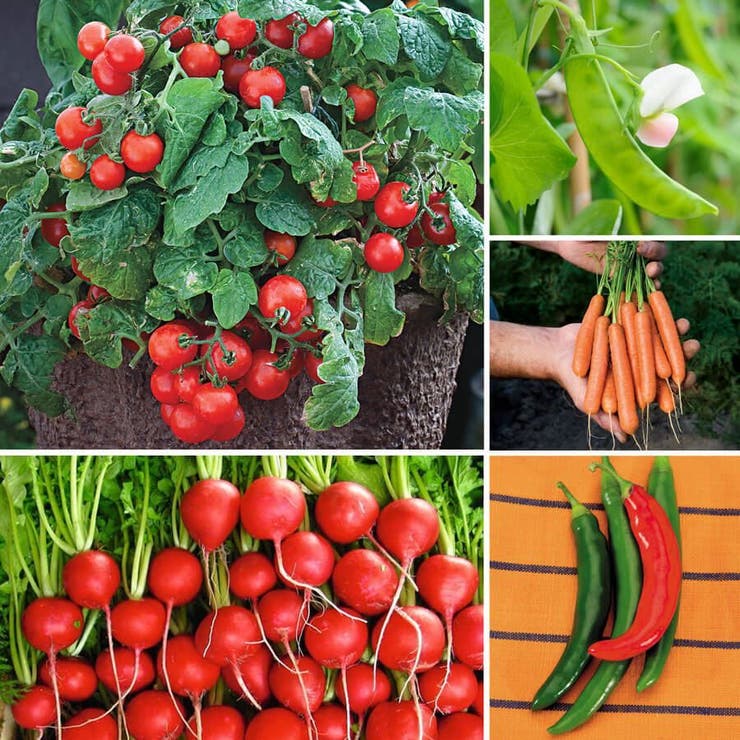How To Grow All Your Vegetables In A 5-Gallon Bucket
Container planting vegetables is not a new concept, but what about using buckets for growing vegetables? Read on to learn more about this method!

Laura Walters

If you only have a small space in which to garden, it doesn’t mean you can’t grow a lot. Bucket gardens are a trend that’s been around a very long time. Buckets are easy to come by, either from bulk cat litter, inexpensively purchased at the hardware store, or sourced from a food service. A bucket garden can fit into most spaces, even a lanai, and it allows for easy control of water, nutrients, and harvest.
Growing Vegetables In Buckets
Container-grown vegetables are fun and convenient. Planting in buckets is a handy way to use up old plastic while garnering a healthy harvest. It is especially useful for plants like tomatoes which need a larger root space and surface area.
In a bucket garden, you can control the soil and the lighting. In areas with heavy clay, bucket-grown plants can luxuriate in a tailor-made soil mixture. When the sun moves, the containers may be easily moved to follow the light. And in zones where late spring freezes occur, containers can be moved indoors for the night, extending the growing season. There are few weeds in a bucket garden, and harvesting is just outside the kitchen door.
How to Grow Vegetables in a Bucket
The first thing to consider is the mature size of the plant. Even root crops can grow well in a bucket, but to ensure root formation they should not be crowded. Larger plants like eggplant, may not work due to the weight of the fruit, but dwarf forms are perfect for bucket gardens. Plants like lettuce don’t necessarily need the depth of a bucket, but can certainly be grown in this manner. Herbs thrive in bucket systems. Plants may be transplanted or started by seed, depending upon the zone and variety of produce.
Creating A Planter From a 5 Gallon Bucket
Make sure the buckets you use for a garden did not contain any toxic compounds, such as oil. It’s always a good idea to wash the bucket out thoroughly before filling it with soil.
The bucket can be a stand alone system just like a plant pot, or a wicking system. In this system, 2 buckets are required. Drill a large hole that will fit PVC piping in one bucket. The upper bucket will contain soil and plants. The lower bucket will contain water, the PVC end and a wicking item such as cloth. This will slowly deliver water up to the plant’s roots. In a simple system, all you need is 1 bucket, a drill, good soil, and some seeds. If your crop will need a very deep container, cut the bottom off of 1 bucket and tie it to the top of another. This will allow for a very deep soil space for large plants.
What Kind of Soil Should You Use?
The type of soil you use for growing plants should support the plants’ needs. Vegetables thrive in a slightly acidic soil that’s well-draining and nutrient rich. The addition of peat moss to the soil mixture will add acidity, while compost can increase nutrient density.
Sign up for the Gardening Know How newsletter today and receive a free copy of our e-book "How to Grow Delicious Tomatoes".
A purchased potting soil, amended as needed, is sufficient for most plants. Using only compost, or manure will not allow adequate air and moisture movement. These are best used as amendments to garden or potting soil. The soil can be reused annually by dumping it out at the end of the season and adding perlite and some compost. Plants in the nightshade family should have fresh soil each year to prevent certain pests and diseases.
Do You Need To Drill Holes?
Plastic buckets don’t evaporate through the sides, only the top surface of the soil. Enhancing drainage is crucial to prevent root and stem rots. The right soil mixture will help with porosity but is no substitute for drill holes. Just like any plant pot, the soil needs to be allowed to drain freely. Drill plenty of holes to ensure excess moisture has somewhere to go. Do not use a drill bit so large that the soil will leech away. A smaller bit, with more holes is a better method.
What Food Grows Well in 5-gallon Buckets?
Long-season crops are best in buckets. Vining plants can be grown in buckets but will need a sturdy support system. Plants with deep root systems like cucumbers and peppers perform beautifully in buckets. Plants in the nightshade family will need 1 pot per plant, while others can grow in groups.
- Tomatoes
- Tomatillo
- Peppers
- Green beans
- Peas
- Beets
- Radish
- Carrot
- Spring onion
- Greens
- Potatoes
- Sweet potatoes
- Eggplant
- Herbs
This article features products available from third-party vendors in the Gardening Know How Shop.
- Laura WaltersContent Editor
